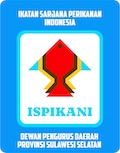STUDI HISTOPATOLOGI GONAD GASTROPODA LAUT (THAIS TUBEROSA DAN MONODONTA LABIO) YANG MENGALAMI IMPOSEKS AKIBAT TERPAPAR TRIBUTYLTIN (TBT)
DOI:
https://doi.org/10.35911/torani.v25i3.2610Abstract
Tributyltin (TBT) is an organotin compound used as antifouling material for ship or boat paints to preventattachment of marine biota on the wall of ships or boats. The most dangerous effect of TBT bioaccumulation onmarine organisms, particularly gastropods, is the failure on the reproduction system, such as the occurrence ofimposex symptoms. The main purposes of this study are to know the histopathology of gonads by species Thaistuberosa and Monodonta labio that has been exposed to imposeks the compound tributyltin (TBT). The samplingof Thais tuberosa and Monodonta labio was conducted at 2 sites: Manado Port and Tateli Coastal Waters. Thehistopathology test was conducted in the Central Diagnostic Laboratory of Anatomic Pathology, Manado, withHaematoxylin-Eosin (HE) technique. The result showed that histopatology gonads marine gastropods type Thaistuberosa and Monodonta labio there has been a change in the tissues showing the imposex character, ifcompared with tissues of normal individuals of male and female, but in these changes tissues not cause damagecaused by a compound tributyltin (TBT).Keywords : Histopatology of gonad, Gastropods, Imposex, TributyltinDownloads
References
Alzieu, C. 2000. Impact of Tributyltin on Marine Invertebrates.Ecotoxicology; 9, 1-2; ProQuest Biology
Journalspg. 71.
Bech, M. 1998. Imposex and Population Characteristics of thais distinguenda as an Indicator of Organotin
Contamination Along the South East Coast of Phuket Island, Thailand. Puket Marine Biological
center Special Publication, 18(1):129-138.
Bech, M. Strand, J., Jacobsen, J. A. 2001. Development of imposex andaccumulation of butyltin in
thetropical muricid Thaisdistinguenda transplanted to a TBTcontaminated site. Environmental
Pollution, 119:253–260.
Castro, I. B., Lima, A. F. A., Braga, A. R. C., and Barreira, C. A. 2007. Imposex in Two Muricid Species
(Mollusca; Gastropoda) from the Northteastern Brazillian Coast. J. Braz. Soc. Ecotoxicol., 2(1):
-91
Castro, I. B., Meirelles, C. A. O., Matthews-Cascon, H., Rocha-Barreira, C. d. A., Penchaszadeh, P., and Bigatti,
G. 2008. Imposex in Endemic Volutid from Nothheast Brazil (Mollusca; Gastropoda). Braz. Arch.
Biol. Technol., 51(5): pp. 1065-1069.
Edward dan Ahmad, F. 2006.Pemantauan Kadar Polutan Tributyitin (TBT) dalam Ait laut dan
Sedimen di Perairan Teluk Jakarta.Balai Dinamika Laut P2O - LIPI Jakarta.
Ellis, D. V. And Pattisina, A. 1990. Widespread Neogastropod Imposex: A Biological Indicator of Global
TBT Contamination ?. Marine Pollution Bulletin, 21(5): pp. 248-253.
Fent, K. (1996). Ecotoxicology of organotins compounds. Critical Review ofToxicology, 26: 1- 117.
Fernandez, M. A., Limavender, A. M., Castro, I. B., Almeida, A. C. M., Wagener, A. d. L. R. 2002. Occurrence
of Imposex InThaishaemastoma: Possible Evidence of Environmental Contamination Derived
from Organotin Compaunds in Rio De Jeneiro and Fortaleza, Brazil. Cad. Saúde Pública, Rio de
Janeiro, 18(2):463-476.
Goding, M. P., Wilson, V. S., Folmar, L. C., Marcovich, D. T., and Gerald, A. 2003.The Biocide Tributyltin
Reduces the Accumulation of Testosterone as FattyAcid Esters in the Mud Snail (Ilyanassa
obsoleta). Environmental Health Perspectives 111.
Harino, H., Fukushima, M., Kawai, S., and Miyazaki, N. 1998.Contamination of Buthyltin and Phenylltin
Compaund in The Marine Environment of Otsuchi Bay, Japan. Environmental Pollution 101 : 209-
Horiguchi, T. 2009. The Endocrine-Disrupting Effect of Organotin Compound for Aquatic Organism.
Ecotoxicology of Antifouling Biocides.Springer. Japan.
Horiguchi, T., Mitsuhiro, K., Fumihiko, H., Akira, K., Hiroaki, S., Masatoshi, M. and Makoto, S. 2006. Impact
of Tributyltin and Triphenyltin on Ivory Shell (Babylonia japonica) Populations. Environmental
Health Perspectives 144: 13-19.
Islami, M. M. 2011. Imposex pada Moluska.Oseana. Vol 33 (4): 41 – 48.
Mensink, B., Hans, K., A. Dick, V., Cato, C. T. H., Jan, H. K., Bert, P. H., and Jan, P. B. 2002. Imposex
Induction in Laboratory Reared juvenile Buccinum undatum by Tributyltin (TBT).
Environmental Toxicology and Pharmacology 11 :49-65.
Midorikawa, S., Arai, T., Harinp., and Cu N. D. 2004. Organotin Levelsin Bivalves in Southeast Asia. Coastal
Marine Science 29(1) : 57-62.
Ohji, M, Arai, T., and Miyazaki, N. 2003.Chronic Effect of Tributyltin on The Caprellid Amphipod
Caprelladanilevskii. Marine Pollution Bulletin, 46:1263-1272.
-----------. 2004. Biological Effect of Low Concentrations of Tributyltin on the Caprellid Amphipod
Caprella danilevskii. Coastal Marine Science 29 (1) : 13-27.
Pandey, E. and Evans, S. M. 1996.The Incidence of Gastropods from Indonesians Coastal Water. Asian
Marine Biology 13: 53-61.
Panggabean, A. S., M. B. Amran, Buchari., and S.Achmad. 2009. Speciation of Organotin Compounds with
Ion Pair-Reversed PhaseChromatography Technique.Eurasian J. Anal. Chem. 4(2): 215-225.
Prouse. N. J., and Ellis , D. V. 1997. A Baseline Survey of Dogwhelk (Nucella lapillus) Imposex in Eastern
Canada (1995) and Interpretation in Terms of Tributyltin (TBT) Contamination. Environmental
Technology, 18: pp.1255-1264.
Rumengan, I. F. M. and Ohji, M. 2012. Ecotoxicological Risk of Organotin Compound on Zooplankton
Community. Coastal Marine Science 35(1) : 129-135.
Wagiman, S. 2004. Imposeks dalam Siput Haliah, Thais sp Sebagai Penunjuk Biologi Pencemaran
Tributiltimah di Perairan Semenanjung Malaysia.Thesis. Fakultas Kejuruteraan Awam. Universitas
Teknologi Malaysia. Malaysia.
Yusuf, M., Zulkifli, S. Z., and Ismail, A. 2011.Imposex Study on Thais tuberosafrom Port and Non-Port
Areas along the West Coast of Peninsular Malaysia. Journal of Tropical Marine Ecosystem 2:1-9



















